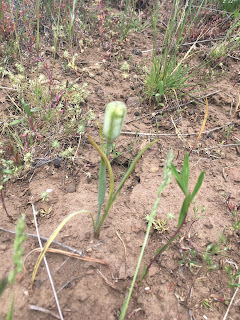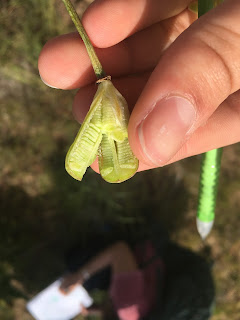For my second field trip, we went to the Eastern Cascade Foothills. The first area we went to had basalt columns from Cascade volcanoes from 20-50 million years a go. The opposite side of the foothills we were at were similar, but the columns are covered by glacial debris. The area had a river running through, meandering for millions of years, followed by a slow uplifting of the land coupled with downward cutting from the river created the canyon we were able to see. The canyon's vegetation was a shrub-steppe zone, receiving an average of 20 inches per year. Pretty gosh darn dry if you ask me! The main trees in the area were Black cottonwood and Ponderosa Pine, also containing wet microhabitats with Willow trees and Oregon grape. We saw lots of cool different birds when we first arrived there, including Yellow breasted chats (a migratory species) who were having a territorial fight with a wing vibration display. These birds are songbirds and are related to Song Sparrows. We also saw Gold Finches, heard Downy woodpeckers and Black headed Grouses, and saw quite a few Red tailed hawks (distinguishable by their slightly upturned wings and broad tails with a red tinge) and Trkey Vultures. We also saw a cherry tree and sage (which smelled awesome). The sagebrush was altered and fragmented because of human land use in the area, and had dry climate adaptations like hairy leaves to break wind that would cause moisture loss and a reduced area of leaf size. Sagebrush also has an extensive deep root system and shallow root system, allowing it to gain water from the water table and from closer to the surface. We saw Brown headed cowbirds, who used to feed off bison until but now thrive on cattle and horse ranches. Because these birds rely on constantly moving animals to feed off of, they cannot lay and protect their eggs, and thus lay their eggs in other birds' nests, in which their larger babies usually crowd out parents' actual babies.

 |
| Purple Lupin |
 |
| Biscuitroot |
 |
| Unknown lichen on Tall Sagebrush |
 |
| Larkspur |
 |
| Unknown lichen growing on rock |
 |
| Indian Paintbrush (parasitic on sagebrush roots) |
 |
| Interesting white foamy goop oozing from this Black Cottonwood. Unsure what exactly what it was |
 |
| Yarrow |
 |
| First landscape |
The second place we drove to was a flatter plain area with shrubs of sagebrush and many similar plants, excluding the wetter habitat areas. We saw two little horned lizards, and there were these interesting seed satchels that would disperse seeds if you hit them. I am unsure what plant exactly they were from. We saw brewer sparrows and sage threshers. There are also rattlesnakes in this area (none of which we saw /: ). The field had a curst on the soil of cryptobiotic crust composed of lichens and mosses, holding the soil together and helping grasses and flowers colonize. The last area we went to was a drainage area from the Columbia River, providing an area for a predominantly Douglas-fir forest, also containing White Aspen and Ponderosa Pine. Lewis and Clark found an artifact from a seasonal native village, showing the creek as important to this village's survival. We saw a spotted Towee bird and hunted and found more than five Morel mushrooms. I also found Elk dung, saw a Water Skeeter, a Mountain Chickadee, Black Alder trees, and Wolf Lichen (which apparently makes really good orange dye).
 |
| Second Landscape |
 |
| Weird seed pods |
 |
| Lichen growing on rock |
 |
| Wild onion (Allium) seed pod |
 |
| Above (opened) |
 |
| Wee Horned Lizard |
 |
| Sagebrush |
 |
| Third Landscape |
 |
| Bluebells |
 |
| Ponderosa Pine new cones |
It was a hot and pretty tiring day, but it was really cool to see the very different drier landscape created by the blockage of moisture from the Cascades. My favorite part of the trip was probably mushroom hunting at the last spot we went to. I thought the aspen forest was absolutely beautiful.























No comments:
Post a Comment